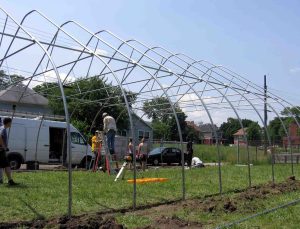Threescore and some days ago, our interns entered the ranks of the UniverCities Connection program. Now, as the days grow shorter, they’re bidding us adieu and headed back to school or, in Jordan Eizenga’s case, moving on to post-college life. The offices of the Suburbs Alliance will be a little emptier without them.
Don’t shed too many tears, though, for there’s much they’ve accomplished. Their regional climate and energy work this summer testifies to the power of tapping young minds from Michigan’s universities to take on the challenges of its cities.
Stephanie assembled a strategy library that the cities of Ypsilanti, Southgate and Hazel Park will use to build individualized climate action plans. It includes more than two dozen entries on everything from A (anaerobic digesters) to W (wind power), detailing energy savings, ancillary benefits, funding and implementation mechanisms, and real-life examples for each strategy.
Jordan Eizenga tunneled through reams of municipal energy bills to assemble data on total energy consumption for the nine cities that have adopted the Millennial Mayors Congress Energy Protocol. Now, for the first time, this data gives them a yardstick to measure their progress towards the Protocol’s 25%-by-2015 energy use reduction goal.
Jordan Garfinkle used his energy expertise to write policy briefs describing how the cities can meet that target. Do they need to know the relative merits of community-based and corporate energy strategies, or learn what conservation strategies have been working for other Michigan cities? It’s all here.
Michael participated in what sometimes seemed like every aspect of Southgate city government. Whether digging up energy records, manning City offices, discussing regional initiatives, or directing traffic, Michael reveled in the “extreme glut of things that need to be done,” and did them with gusto.
The interns’ work struck at “the real meat of environmentalism in local policy,” in Jordan E.’s words. These young people have made the region’s first collaborative effort to curb energy use possible. Putting their university training to work outside the ivory tower, they’ve done what cities couldn’t accomplish on their own. The Millennial Mayors Congress and Regional Energy Office will ensure their work doesn’t sit on a shelf, but reverberates far into the future, as cities establish mechanisms for meeting the Energy Protocol and pilot local climate plans.
Just as important, though, is how the summer’s work has sustained and strengthened the interns themselves. Don’t go yet; we’ll be checking in on them later this week!









